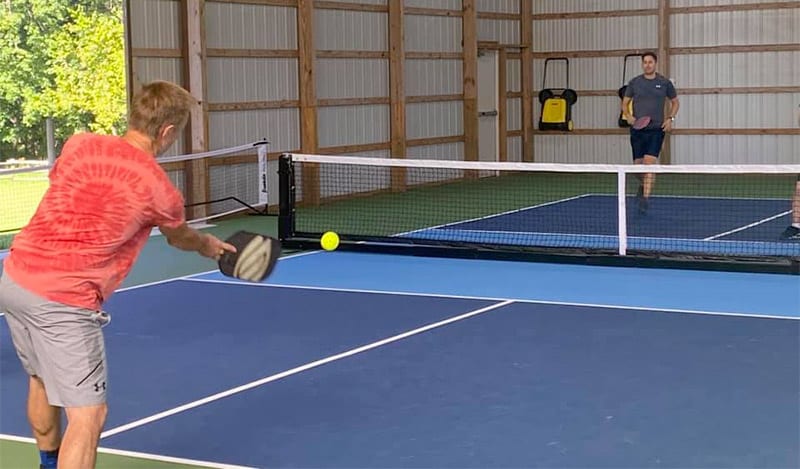One of the terms exclusive to Pickleball is the Erne, more affectionately known as the Pickleball Ernie.
“The Erne shot” was first coined by a videographer named Jeff Shank during the USAPA National Pickleball Tournament held in 2010 in Buckeye, Arizona.
Shank came up with the term after watching one of the tournament’s players, Erne Perry, dominating rallies using the shot.
Erne Perry didn’t invent the shot itself, and Erne admitted learning the move after another player used it effectively against him during a match in the 1990s.
Perry indeed grew the Erne’s popularity with his consistent and effective use of it during the Buckeye tournament.
What is a Pickleball Ernie?

An Erne is a volley played outside the non-volley zone of a Pickleball court.
It is an advanced shot that has become immensely annoying to the vast majority of Pickleball players but, when executed correctly, is a surprise shot that catches opponents off guard.
An Erne is carried out by playing the ball from an out-of-bounds position and performing an effective shot by hitting the ball cross-court at such an angle that an opponent will struggle to hit it.
Why is an Erne Shot so Effective?
You hit an Erne very close to the ball’s apex from a high-up position.
As a result, the player can hit the ball downward instead of waiting for it to come down near the kitchen line, where hitting upwards would be the only option to get it over the net.
You also have the element of surprise when you hit an Erne, as no opponent expects anybody to hit a ball out of the air at such proximity to the net.
Nowadays, the mere thought of the possibility of an Erne shot happening creates stress in the opposition, meaning errors are more likely.
How to Set Up an Erne Shot
It’s probably not wise to attempt to set up an Erne too early in a game.
Hitting an Erne will require patience and observing your opponent’s shot patterns before deciding on its viability.
After that, you’ll need a combination of anticipation, agility and speed to pull the shot off successfully.
As you need to be in position outside the court’s playing surface, either to the right or left of one of the sidelines, it’s imperative to lay the trap for your opposition and get them to play a straight dink close to the sideline, where you’ll be able to reach across the non-volley zone and hit the volley without infringing by stepping into the zone itself.
To set up an Erne in Pickleball means practicing the execution and being extremely patient while waiting for an opportunity to put your practice, well, into practice.
You’ll likely have to set the trap by hitting a dinking rally of various depths and locations before dinking deep close to your opponent’s sideline.
If all goes to plan, your opponent, not even considering the Erne is an option, will react by dinking straight close to the sideline, as the alternative shot across the court is much more challenging to negotiate.
Your patience has paid off, and you’ll have the chance to attempt an Erne.
Although it sounds pretty simple, it is anything but.
Even when your opponent is in the process of playing the straight dink, you’ll have to anticipate the exact time to move out of the court.
From there, it’s all about timing – your initial movement, your reaction to your opponent’s dink, and your later action to ensure you don’t enter the non-volley zone after playing the Erne.
If the shot is successful, prepare yourself for a fair amount of moaning from your opponents and even more applause from onlookers on the sideline.
Why is the Erne Legal in Pickleball?
The Erne is a legal shot in Pickleball as, according to the official rules of Pickleball, any volley made from outside the non-volley zone is legal.
So, in essence, you cannot hit a volley from within the court region between the service areas and the net, as marked with the NVZ line.
This technicality makes the Erne legal as it is not infringing any of the game’s official rules.
This non-volley zone, or kitchen zone, spans seven feet, and players usually use the rule to dink the ball, so it clears the net and bounces within the kitchen line of their opponent.
How Can You Defend Against an Erne in Pickleball?
If you get caught out by an Erne shot, there’s not a great deal you can do.
The best defense against this shot is to restrict any chance of your opponent playing it.
Always keep an eye on where your opponent is, and with the Erne in mind, try not to play the ball into an area of the non-volley zone where your opponent could use the Erne against you.
If the opposition does manage to slip an Erne into play, the best you can attempt to do is hit the ball back in the direction of your opponent’s body.
There’s always a chance that, with a bit of luck, the ball may touch them when they’re back in the non-volley zone, which would cause a fault against them.
Remember that it’s against the rules to tag another player intentionally, so if you’re in two minds, perhaps attempt to lob the ball instead.
FAQs
Must an Erne shot go over the Pickleball net?
In an adaption of the Erne, if a dink is hit wide enough, an opponent can play a return that bypasses the net and lands in the opposition’s court, known as an around-the-post shot.
Am I allowed to reach over the net in Pickleball?
Rule #11 states: “If the ball bounces into a player’s non-volley zone with enough backspin as to cause it to return over the net, the player may reach over or around the net to hit the ball but may not touch the net system or the opponent’s court.”
